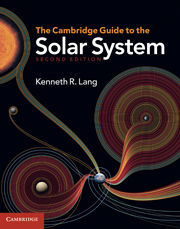Book contents
- Frontmatter
- Contents
- List of focus elements
- List of tables
- Preface to the second edition
- Preface to the first edition
- Principal units
- Part 1 Changing views and fundamental concepts
- Part 2 The inner solar system: rocky worlds
- 4 Restless Earth: third rock from the Sun
- 5 The Earth's Moon: stepping stone to the planets
- 6 Mercury: a dense battered world
- 7 Venus: the veiled planet
- 8 Mars: the red planet
- Part 3 The giant planets, their satellites and their rings: worlds of liquid, ice and gas
- Part 4 Remnants of creation: small worlds in the solar system
- Part 5 Origin of the solar system and extrasolar planets
- Author index
- Subject index
4 - Restless Earth: third rock from the Sun
from Part 2 - The inner solar system: rocky worlds
Published online by Cambridge University Press: 05 August 2011
- Frontmatter
- Contents
- List of focus elements
- List of tables
- Preface to the second edition
- Preface to the first edition
- Principal units
- Part 1 Changing views and fundamental concepts
- Part 2 The inner solar system: rocky worlds
- 4 Restless Earth: third rock from the Sun
- 5 The Earth's Moon: stepping stone to the planets
- 6 Mercury: a dense battered world
- 7 Venus: the veiled planet
- 8 Mars: the red planet
- Part 3 The giant planets, their satellites and their rings: worlds of liquid, ice and gas
- Part 4 Remnants of creation: small worlds in the solar system
- Part 5 Origin of the solar system and extrasolar planets
- Author index
- Subject index
Summary
• Seismic waves generated by earthquakes have been used to look inside the Earth, determining its internal structure.
• There is a crystalline globe of solid iron at the center of the Earth that spins faster than the rest of the planet. This inner solid core is suspended in a much larger, fluid, outer core of molten iron, which is itself encased in a thick mantle of solid rock.
• The continents disperse and then reassemble, over and over again, roaming about the planet in an endless journey.
• Sound waves and gravitational data have been used to effectively empty the Earth's oceans and see their floors, revealing an underwater range of active volcanoes that snakes its way around the middle of the ocean floor.
• The bottom of the oceans remains in eternal youth as new floor spills out of mid-ocean volcanoes and old floor is pushed back inside the Earth, but the water above the floors has remained for billions of years, shifting about the globe as new oceans open up and old ones close.
• The outer part of the Earth is broken into a mosaic of large plates, like the cracked pieces of an eggshell; these plates move across the Earth at the rate of a few centimeters per year, or about as fast as your fingernails grow.
• Wheeling, churning motions deep inside the Earth's hot interior move continents sideways all across the planet. […]
- Type
- Chapter
- Information
- The Cambridge Guide to the Solar System , pp. 117 - 157Publisher: Cambridge University PressPrint publication year: 2011



